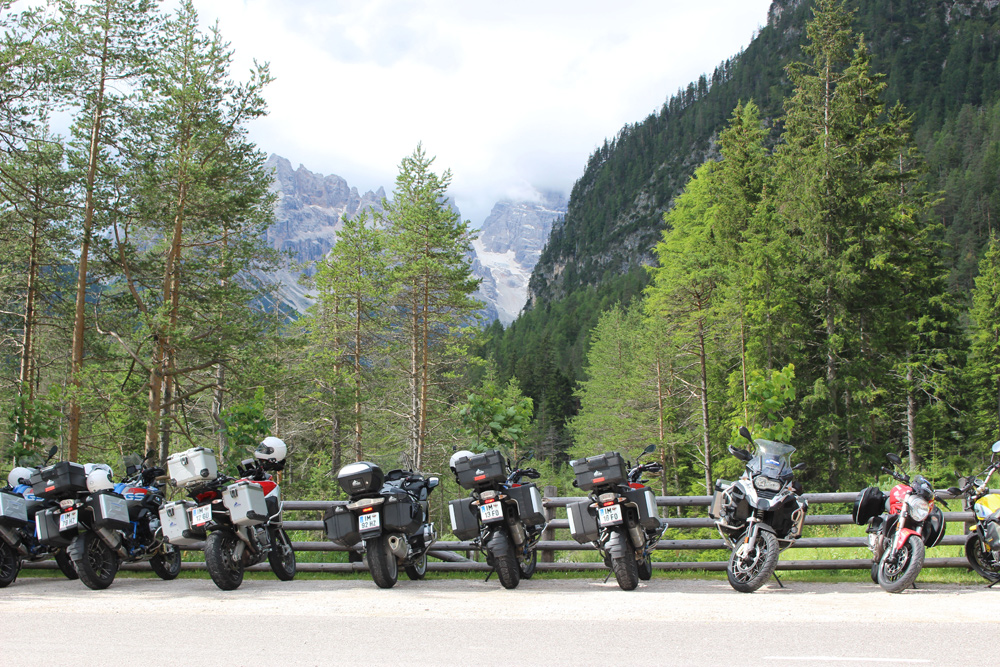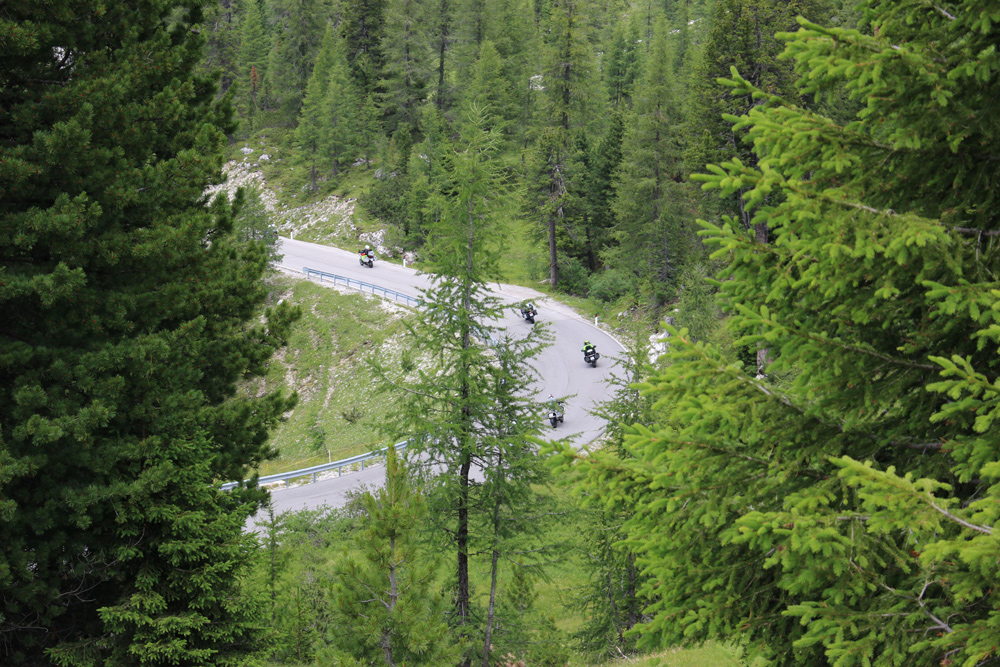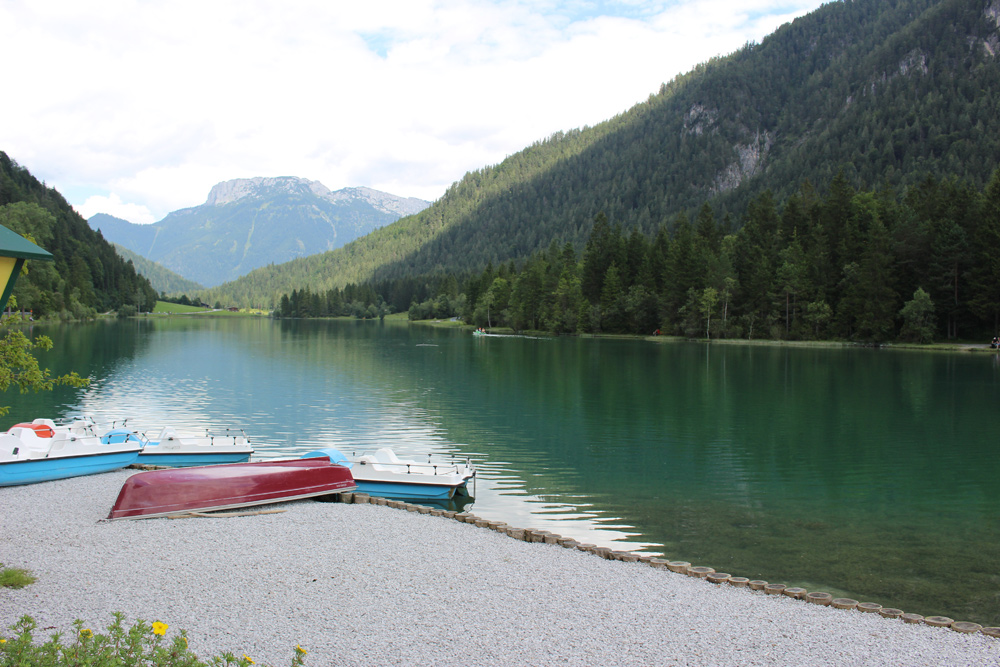Sean Finley | November 12, 2018
Bucket List
We tour the Alps with Edelweiss Motorcycle Tours
 If you are looking for an amazing motorcycle adventure with spectacular scenery, historical sites and first-class guidance, an Edelweiss tour is well worth the price.
If you are looking for an amazing motorcycle adventure with spectacular scenery, historical sites and first-class guidance, an Edelweiss tour is well worth the price.
Touring Europe on a motorcycle has been on my bucket list for several years and the stars finally aligned to make this possible. Attending the EICMA and Intermot motorcycle shows in Italy and Germany a few times each over the past 20 years gave me a sense of just how passionate the Europeans are for motorcycles. A one-day tour of the Alps in a rental car during one of those trips exposed me to the beautiful roads, scenery and historical treasures on the continent.

During that tour, we saw hundreds of motorcycles and one of the packs was an Edelweiss tour group enjoying a coffee stop. A quick chat with those riders put this right at the top of my bucket list, but life and a busy work schedule made it seem almost impossible to check that off my list.

After nearly 20 years of anticipation, I was a little concerned that now that my wife and I were finally on our way to Europe for the Edelweiss High Alps Tour that my expectations would be difficult to achieve. Now that I sit on the plane returning home nine days later, I am happy to say that this trip blew away those expectations.


The Edelweiss crew has been doing motorcycle tours since 1980 and the passion, preparation and attention to every detail is amazing. The motorcycles, routes, stops, hotels and meals are all first class. The tour guides are well trained and follow specific procedures to ensure a top-quality, enjoyable and safe experience for all the participants.

How do you choose a motorcycle tour?
After looking through several tour options on the Edelweiss website, we finally settled on the High Alps Tour, which includes seven nights and six riding days starting in Munich, Germany, traveling through Austria, Northern Italy, Switzerland, a quick ride through Lichtenstein (a small principality) and finally back into Germany.

Each night was a new destination/hotel except for nights three and four, which included two nights in Bolzano, Italy. Day three was an optional riding or “rest” day. Edelweiss currently offers 70 different tour options throughout the world with varying levels of support and with or without guides. We were on the Classic option, which includes two guides, one on the bike with the group each day while the other transports luggage to the next destination. Each tour on the website has a 1-5 ranking for riding difficulty, riding time per day and sightseeing so you can choose one that fits your desires.
 Ursala was the second of our two tour guides. Each day, one of the two rode with the group while the other drive the van to the next destination with the luggage and a spare motorcycle. Ursala felt like a best friend almost immediately and provided a lot of great guidance.
Ursala was the second of our two tour guides. Each day, one of the two rode with the group while the other drive the van to the next destination with the luggage and a spare motorcycle. Ursala felt like a best friend almost immediately and provided a lot of great guidance.
Our Group and Motorcycles Chosen
Edelweiss has several makes and models of motorcycles to choose from but the BMW R1200 GS is the most popular option and we saw hundreds of them on the roads during our tour. All the bikes include sidebags to carry items during the day, and all the bikes with two riders include a top trunk, which is a greatly appreciated back rest for the passengers. Our group of 14 riders/passengers and nine bikes included the following:
- Dan and Jacqueline, newlyweds from Las Vegas. They were riding a Ducati Monster and Ducati Scrambler, respectively.
- Bob and Susan, a couple from Michigan. Two-up on a BMW.
- Mike and Debby, a couple from Colorado. Two-up on a BMW R1200 GS.
- Duane and Glenda, also from Colorado and friends of Mike and Debby that “invited themselves” on the trip when they heard about it over dinner. Two-up on a BMW R1200 GS.
- Mike and Cathy, a retired couple from Texas. Two-up on a Ducati Multistrada 1200.
- Bill, a recently retired Connecticut firefighter. BMW R1200 GS.
- Jay, a Connecticut riding buddy of Bill’s. BMW GS.
- My wife and I rode two-up on a BMW R1200 GS.
 Dan and his wife Jacqueline were celebrating their honeymoon, but unlike most of the rest of our group, they chose to ride their own bikes.
Dan and his wife Jacqueline were celebrating their honeymoon, but unlike most of the rest of our group, they chose to ride their own bikes.
Our group ranged in age from 30 to nearly 70 and the riding experience was also broad but, fortunately, we quickly found a common groove and pace that worked well for everybody. Faster riders were free to speed up to road and wait up at the next stop and, if you choose, Edelweiss policy allows you to just do your own thing all day if you prefer, but we stuck together. It was unusual that we were all from the U.S., as our guides noted that about 60% of participants are from the U.S., so the groups typically offer more diversity and options to spend time with more people from different parts of the world.
 One of the advantages of a guided tour over a self-guided tour is the hidden gems like this fine restaurant on a back road in Switzerland.
One of the advantages of a guided tour over a self-guided tour is the hidden gems like this fine restaurant on a back road in Switzerland.
Edelweiss Tour Guides and Guidance
Our guides included Ursala, a German woman who still lives in the small village not far from Munich where she grew up. She has adult children (and even a granddaughter) and has been an Edelweiss tour guide for nearly 15 years., Godfried, an “Italian,” who, as we learned from our tour, is from a northern part Italy that was part of Austria prior to being taken over after the end of World War I. This northern region, including the city of Bolzano, or Bozen, that we stayed for our rest day, still has deep Austrian roots and most of the citizens consider themselves more Austrian than Italian. Most of this region includes both German and Italian names and both languages are used. Godfried has been an Edelweiss guide for eight years.
 Godfried was one of our two tour guides and his riding tips, local knowledge of the roads, coffee stops and historical points of interest made the trip that much more amazing.
Godfried was one of our two tour guides and his riding tips, local knowledge of the roads, coffee stops and historical points of interest made the trip that much more amazing.
It felt like we got the two best guides available, but Ursala and Godfried assured us that all 50-plus Edelweiss guides follow similar procedures and are equally well trained. All the guides do an annual training program to keep everybody fresh. They kicked off the tour with helpful riding, group riding and safety recommendations including the “Edelweiss line” suggested for the narrow European roads. I especially appreciated the proper procedure for using roundabouts, which are abundant in Europe.
 Edelweiss Tours believes that motorcycles are the best was to experience a location and we couldn’t agree more. Our group of fourteen people zipped around amazing roads, stopped at spectacular locations and enjoyed the riding as much as the history and the scenery.
Edelweiss Tours believes that motorcycles are the best was to experience a location and we couldn’t agree more. Our group of fourteen people zipped around amazing roads, stopped at spectacular locations and enjoyed the riding as much as the history and the scenery.
The safety and riding tips were reinforced every day during the route briefings that also included the historical highlights for the region. Edelweiss offers options to rent bikes and pre-loaded GPS routes but after spending the week with our guides, I recommend that option, especially if it is your first motorcycle tour outside the U.S.
 Just another amazing road; this one in Austria. During five riding days, the roads and views like this were almost nonstop.
Just another amazing road; this one in Austria. During five riding days, the roads and views like this were almost nonstop.
Edelweiss High Alps Tour Route Highlights
Many of the Edelweiss tour options cross some of the same well-known and lesser-known—but equally fantastic—roads passes and historical highlights in the Alps region. Those options vary in number of days, difficulty of the routes and amount of support. (The “extreme” tours don’t include the support van, for example.) They also fine-tune the routes, hotel choices, tourist/historical stops and coffee/lunch stops based on participant feedback. The website ranks the rides in terms of difficulty level, mileage and tourist stops but you’ll find that Edelweiss tours emphasize riding over tourist destinations. So, you can expect to ride a lot and do some relatively quick stops at a few castles or historical locations.

Our High Alps tour included some famous passes including the Grossglockner, Stelvio, and Gavia. Austria’s Grossglockner has great pavement with tight switchbacks and an amazing view of a glacier at the top. The Stelvio Pass includes beautiful views, extremely tight switchbacks and, on most days, a lot of cyclists, motorcycles and cars, so it is not an exciting road to ride but is quite a spectacle.


The Gavia is famous for being a regular route on the Giro d’Italia bicycle stage race (Italy’s “Tour de France”) and it is not much more than a roughly paved goat trail. There are very few guard rails and some scary cliffs, but the views are stunning. For quality higher speed roads, the Bernina and Albula Passes in Switzerland offered perfect asphalt and sweeping corners that allows for some fun lean angles.

Besides the twisty roads, the sheer number of amazing views, towns and villages along the route is unbelievable. On day one, leaving the Munich area, we started off twisting our necks every mile and at every small town and this never ended after six full days of riding. There are castles, churches and buildings that have been standing since long before the United States even existed. And the view of the Alps and Dolomite peaks are equally impressive.

How do you pack for an Edelweiss Motorcycle Tour
The weather is very unpredictable in Europe and especially in the Alps. The weather apps on our phones prior to leaving showed 80-plus percent chance of rain every day and relatively cool temperatures as we packed, and, in the end, we only had real rain on parts of two of the six days. Fortunately, only one brief thundershower at the end of one day was extreme.

With the large variances in altitude during the route, the temperatures changed dramatically but were generally warmer than the weather apps said it would be. Godfried told us several times to ignore the apps and said, “if you want to know how the weather is going to be today, just step outside and you only know how it will likely be for the next 30 minutes.” So you have to pack for warm, cold, wet and dry conditions. That is where those sidebags on the bike and van transporting additional luggage really comes in handy.

Recommended items include:
- A helmet that you are familiar with and will be comfortable all day for several days.
- Anti-fog face shield or pin-lock insert.
- Waterproof riding jacket.
- Waterproof riding pants.
- Both hot- and cold-weather gloves.
- Water proof riding boots.
- A communication system if you are riding two-up is great for talking and pointing out the scenery.
- GPS is not necessary if you ride with the guide but could be useful if you decide to do your own route. They are available to rent.
- International converter to charge all your phone and communications system daily
- 12-volt chargers are standard on many of the bikes but use a different plug than the typical cigarette lighter plug we are used to. So you may want to buy that “Euro-” style plug if you want to charge your phone or your own GPS while riding.
 This provided lunch stop in the middle of the Alps was a highlight among highlights.
This provided lunch stop in the middle of the Alps was a highlight among highlights.
How much will this cost me?
The tour cost varies depending on the tour selected, total days, support level, etc. The Classic Tours are in the $2500 and up range per person. The Classic Edelweiss tours include most of the major items: bike rental, hotels, breakfast and dinners. The High Alps Tour that we did was $3600 per person, including an upgrade to the BMW 1200 GS. In addition to the tour cost, you will need to budget for the following:
- Flights to the starting/ending point.
- Lunch for many of the days are on you.
- Airport parking and/or transportation from home.
- Transportation to and from the destination airport/hotel and back.
- You are responsible for fuel for the bikes during the tour. The BMW GS 1200 we rode typically got filled up each day with a cost of around $20 to $30 euros (1 euro = 1.16 dollars during our trip so that was $23 to 35 per day).
- Fees at a few National Parks and/or museums/tourist destinations. We only had one National Park fee and a tour of one of the King Ludwig castles (less than $20 euros each) during our tour.
- Additional insurance on the bike is worth it. It was less than $300 for the week to do the cover-all option that means you have no cost for any damages.
- Additional hotel nights for early arrival or late departure. It is highly recommended to come in a day early to help acclimate to the time zone.
So this is not an inexpensive excursion but our entire group felt that it was well worth it.
 The village at the top of the Stelvio Pass included several food stands and shops. You could sit there for hours watching the parade of people cresting the summit.
The village at the top of the Stelvio Pass included several food stands and shops. You could sit there for hours watching the parade of people cresting the summit.
Do It!
If a European motorcycle tour is not already on your bucket list, it should be. If you enjoy riding your motorcycle on spectacular roads, like history, and beautiful scenery and can afford the cost and vacation time, an Edelweiss motorcycle tour will certainly be worth it. Their service, preparation and guidance make this a turnkey, first-class adventure. We will be saving up and planning for the next trip.CN
Click here to learn more about Edelweiss Motorcycle Tours.